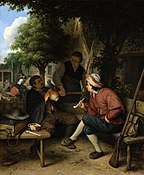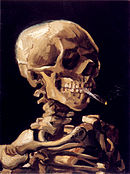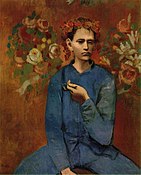Tobacco and art
| Part of a series on |
| Tobacco |
|---|
 |
Depictions of tobacco smoking in art date back at least to the pre-Columbian
Maya art
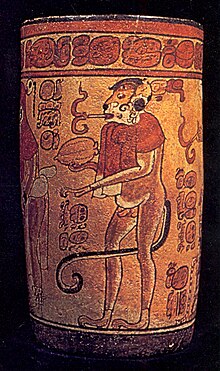
Numerous depictions of smoking can be found from the
Codices
Mayas created
Stone monuments and frescos
The Sanctuary of the Temple of the Cross at Palenque (a Maya city in current Mexico) houses a monument called "El Fumador" (Spanish for "The Smoker"). The stone door panel features an elderly deity blowing smoke from a large cigar. Because of the cigar's funnel shape (which compares to cigars currently used by rural South American tribes) and the outward flaring smoke, scholars believe the monument depicts a religious ritual similar to those performed by other Native American tribes.[3] No other stone monuments depicting smoking are known, but there may have been others.[3]
The only known Maya painting to depict smoking is found at Tulum (a Maya city on the Yucatán Peninsula in current Mexico). The Temple of the Diving God houses the fresco, and the painting features monsters (perhaps birds) smoking large cigars.[3]
Ceramics and other artwork
Mayans also portrayed smoking on
The Vase of the Danse Macâbre depicts a smoking skeleton carrying a jar or pouch and another skeleton and two jaguars also holding pouches or jars. The carried objects are believed to hold tobacco or tobacco mixed with other substances.[3] They display the sign of darkness, so tobacco may have been associated with rituals relating to death.[3]
Though the majority of depictions show gods and lords, some artifacts portray the everyday. For example, the Plate of the Smoking Husband depicts a man smoking a cigarette and his wife rolling dough inside their home.[3]
Other artifacts depicting smoking have also been found including a shell carving, which is now housed at the Cleveland Museum of Art.[3]
Dutch art during the Golden Age

The ordinary person in the 17th century

Moreover, pipes, especially a pair of crossed pipes, symbolized rhetoricians—guilds of actors and poets that held festivals emphasizing pleasure.
Because of economic interests in importing tobacco from the New World to Europe and even starting domestic tobacco farming, Amsterdam merchants worked to reduce smoking stigmatization.[5] By the late 17th century, smoking long-stemmed and polished pipes became acceptable for more respectable males while the lower classes smoked from cruder and shorter pipes. Snuff also gained popularity, and depictions of smoking and tobacco in paintings and drawings became more representative of the mundane and everyday than comically absurd situations and social outcasts.[5]
18th century to 21st century
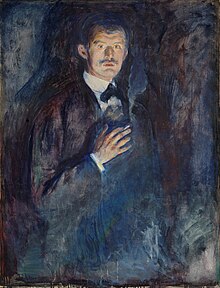
Following the
In the late 18th century and early 19th century, smoking took on new and varied symbolic meanings. During this time period, men were the primary smokers, and smoking was not an acceptable habit for women who were expected to be ideal mothers or mistresses.
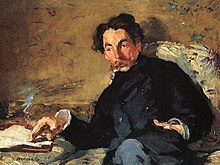
The
By the 20th century, cigarettes, cigars, and pipes all had their own specific meanings and connotations that developed across history. By playing off these meanings, artists conveyed a fuller understanding of an artwork to the viewer. For example, the cigar came to represent a social status symbol, and artists included cigars in paintings to show emphasize social classes and power differences. Heinrich Maria Davringhausen’s The Black Marketeer depicts a boss with a boxful of cigars and a lit one at the edge of his desk. This demonstrates the unequal social relationship between the employer and the employee.[6] Pablo Picasso also used the pipe in his piece called The Poet. This painting relies on the inseparable connection between literature and the pipe to provide the viewer with a better understanding of the painting.[6]
Pop art
With the rise of
Modern art
Various forms of
Smoking, women, and art
During the 17th century, Dutch paintings with women and pipes symbolized misfortune. Women in these paintings are rarely the ones in possession of the pipe, and the Dutch artists meant to send a moral message that foolish behaviors like smoking will lead people into hardships.[6]
Artwork in the 18th century included pipes to convey an exoticism and eroticism even though depictions of smoking went out of fashion in the Western World.[6] An example is Jean-Étienne Liotard’s A French Woman in Turkish Costume in a Harmam Instructing her Servant, which features a woman with a long pipe standing in a position of authority.
In the 19th century, artists, caricaturists, fine potters, and even novelists depicted women smoking. Though portrayals of women smokers became more common, they were shown in a negative light because smoking was still not acceptable for women.[9] During this time, artwork that incorporated smoking was kept in rooms reserved only for men including smoking saloons, billiard rooms, and libraries.[6] Impressionists employed pipes to distinguish males from females and emphasize their different social statuses. In Georges Seurat’s A Sunday Afternoon on La Grande Jatte, the male in the white suit holds a cigar, and even in this snapshot of everyday life, there is an implicit hierarchy between him and the woman who is with him.[6]
Prostitutes were the first women in this time period to be depicted with pipes, cigars, or cigarettes as seen in artwork from Vincent van Gogh and

Resulting from new representations of women smokers from artists like Frances Benjamin Johnston and Jane Atché, smoking became more socially acceptable for women. Eventually, smoking grew into a phenomenon for women. Tobacco products took on varied meanings in the 20th century. During the Roaring Twenties, women smoked cigarettes to appear chic and sophisticated.[6] Yet, paintings with female prostitutes holding with cigars took on a negative meaning because women from low classes were not meant to have objects connected with the upper class. These pieces showed women as seductresses who tricked men into giving them wealth and power.[6]
Smoking began losing its attractiveness as the 20th century progressed, and art followed this trend. Artists mocked the cigarette industry for using highly sexualized images of women in advertising.[6] Mel Ramos created artwork depicting naked women on cigars. Tom Wesselmann exploited the clichés of sex and cigarettes by painting an exposed breast behind an ashtray.[6] Present day artists acknowledge smoking as a health risk, but some want to fight modern, taboo perceptions of tobacco instead of demonizing smoking. Sarah Lucas’s photo titled "Fighting Fire with Fire" shows herself with a cigarette in the corner of her mouth. This one picture sums up the evolution of the relationship between woman, smoking, and art. According to Benno Tempel, this photo shows that "at times when society tries to create taboos, art can break through them".[6]
Gallery
-
The Smoker by Adriaen van Ostade
-
An Apothecary Smoking in an Interior (1646) by Adriaen van Ostade
-
Resting Travelers (1671) by Adriaen van Ostade
-
Man Smoking and Drinking (1859) by Frederick William Fairholt
-
Jews Taking Snuff (1885) by Emanuel Salomon Friedberg-Mírohorský
-
Still-life of Straw Hat and Pipe (1885) by Vincent van Gogh
-
Skull of a Skeleton with Burning Cigarette (1885 or 1886) by Vincent van Gogh
-
Still-life with Straw hat (1888) by Vincent van Gogh
-
Monsieur Louis Pascal (1893) by Henri de Toulouse-Lautrec
-
Man with Pipe (1892) by Paul Cézanne
-
Smoking shisha at the teashop (1892) by Enrique Simonet
-
Boy with a Pipe (Garçon à la pipe) (1905), oil on canvas by Pablo Picasso
-
Self-portrait (1918) by Enrique Simonet
-
Couple in a room by Ernst Ludwig Kirchner
References
- ^ a b c d Robicsek, Francis. "Tobacco and Religion." The Smoking Gods: Tobacco in Maya Art, History, and Religion. Norman: University of Oklahoma, 1978. 27–36. Print.
- ^ a b c d e f g Robicsek, Francis. "The Classification of Archaeological Material." The Smoking Gods: Tobacco in Maya Art, History, and Religion. Norman: University of Oklahoma, 1978. 111-13. Print.
- ^ a b c d e f g h i j k l m Robicsek, Francis. "Scenes Almost Certainly Representing the Act of Smoking." The Smoking Gods: Tobacco in Maya Art, History, and Religion. Norman: University of Oklahoma, 1978. 114-45. Print.
- ^ Robicsek, Francis. "Tobacco and the Mayas." The Smoking Gods: Tobacco in Maya Art, History, and Religion. Norman: University of Oklahoma, 1978. 11–26. Print.
- ^ a b c d e f g h i j k l Gaskell, Ivan. "Tobacco, Social Deviance, and Dutch Art in the Seventeenth Century." Looking at Seventeenth-Century Dutch Art: Realism Reconsidered. Ed. Wayne E. Franits. New York: Cambridge UP, 1997. 68–77. Print.
- ^ a b c d e f g h i j k l m n o p q r s t u v Tempel, Benno. "Symbol and File: Smoking in Art since the Seventeenth Century." Smoke: a Global History of Smoking. Ed. Sander L. Gilman and Xun Zhou. London: Reaktion, 2004. 206–217. Print.
- ^ Brett, Guy. "Jac Leirner's Lung." Web log post. Box Vox. 2 December 2009. Web. 28 April 2010. <http://www.boxvox.net/2009/12/jac-leirners-lung.html>
- ^ Polke, Sigmar. Why Can't I Stop Smoking. 1964. Dispersion and Charcoal on Canvas. St. Louis Art Museum, St. Louis, MO
- ^ a b c Mitchell, Dolores. "Women and Nineteenth- Century Images of Smoking." Smoke: a Global History of Smoking. Ed. Sander L. Gilman and Xun Zhou. London: Reaktion, 2004. 206–217. Print.



